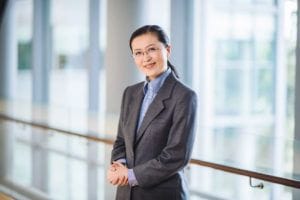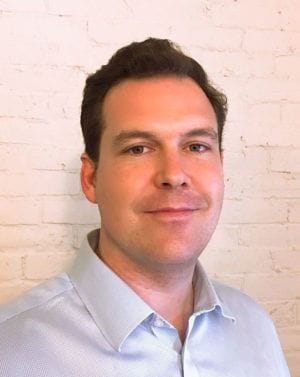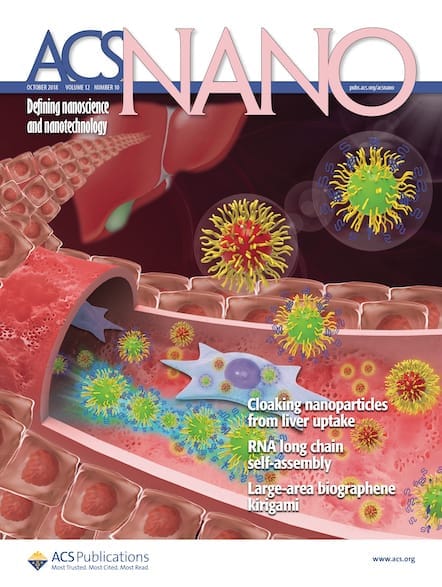The winners of the 2019 ACS Nano Lectureship Awards are Professor Naomi Halas of Rice University for the Americas, Professor Bin Liu of the National University of Singapore for Asia/Pacific, and Professor Jamie Warner of the University of Oxford for Europe/Africa/Middle East. All three winners are frequent contributors to ACS Nano. The winners will present […]

The winners of the 2019 ACS Nano Lectureship Awards are Professor Naomi Halas of Rice University for the Americas, Professor Bin Liu of the National University of Singapore for Asia/Pacific, and Professor Jamie Warner of the University of Oxford for Europe/Africa/Middle East. All three winners are frequent contributors to ACS Nano. The winners will present their award lectures, as well as three complementing talks at ChinaNano in Beijing this August.
Read more about the three winners of this year’s ACS Nano Lectureship Awards:
Naomi Halas
Professor Naomi Halas is the Stanley C. Moore Professor in Electrical & Computer Engineering; Professor of Biomedical Engineering, Chemistry, Physics & Astronomy; and Director of the Laboratory for Nanophotonics at Rice University. She is a pioneer in the field of nanoplasmonics and her groundbreaking work includes creating the concept of the tunable plasmon, generating nanoparticles with resonances that span the visible and infrared regions of the spectrum and innovating the use of plasmonic nanoparticles in biomedical and energy applications. She serves on the editorial advisory board of ACS Nano and Nano Letters.
Read a short interview with Professor Naomi Halas:
I was interested in the idea of manipulating optical properties by designing and building nanostructures from the very beginning, that is, from the point where our ability to do so began to exist.
It seemed much more interesting to me than trying to figure out why materials grown by other means had the properties they did.
We are currently designing and developing complex nanoparticles that lower barriers for photo-driven chemical reactions. They offer methods for doing chemistry at temperatures and pressures far below what is conventionally used. This research direction has the potential to completely change the way we do chemistry and that is extremely exciting.
I am particularly proud that so many people have cited our work, it means that they find what we have discovered and demonstrated to be useful and valuable to their own research and that they have learned new science from what we’ve done: that is particularly satisfying.
It is very satisfying to see that your work has touched people’s lives and that has inspired real-world applications both directly and indirectly.
I am not sure that mentoring is particularly well understood: the concept is frequently misused. Anyone can be a mentor for you and you can be a mentor for many people: indirectly as well as directly.
I don’t want to name my role models lest I embarrass them. But I have many.
Aggressively pursue things that are new and novel. The most interesting and exciting science is such because it is unexpected or counterintuitive. Having theory and experiment agree all the time is boring- it is more important to pursue unknowns where theory and experiment do not yet agree: what is going on there, really?
They say that armies lose when they prepare for the last war: I think there is a lesson there for educating ourselves. There are new and emerging fields and concepts appearing at a rapid rate: to be prepared for the future it is important not to put the blinders on but to look at emerging fields and ask yourself if some of those new concepts could be useful and could take your own work, perhaps your career, in exciting new directions.
Bin Liu

Professor Bin Liu is Provost’s Chair Professor and Head of the Department of Chemical and Biomolecular Engineering at the National University of Singapore. Her innovative research focuses on the design and synthesis of organic nanomaterials and explores their applications in optoelectronic devices and biomedical research, including advances in solar cells, bioimaging, and cancer therapy. She serves as the founding deputy editor of the new journal ACS Materials Letters.
Read a short interview with Professor Bin Liu:
Being trained as an organic chemist, I started from research on water-soluble conjugated polymers with applications in organic electronic devices. During my postdoc, we were able to prepare water-dispersible conjugated polyelectrolyte nanoparticles and successfully extended their applications to the biomedical field. Nanotechnology is a multidisciplinary realm where traditional physicists, chemists, biologists, and engineers meet and produce new discoveries in the nanoscale. When it came to a stage that synthesizing conjugated polyelectrolytes was so slow, we looked into nanoparticle fabrication through nanoprecipitation, which allowed us to quickly bring almost all the conjugated polymers into aqueous media for their biological performance evaluation. I believe in nanotechnology, which has huge potentials to make a real impact on a variety of fields in the near future.
We are developing organic functional materials and exploring their applications in biomedical and clean energy sectors. We endeavor to realize the visualization of crucial biological processes and noninvasive treatment for some diseases using biocompatible organic materials, especially those with aggregation-induced emission characteristics. In the clean energy sector, we aim to convert solar energy into clean and accessible energy fuels or value-added products by developing highly efficient organic semiconductor catalysts.
I appreciate original and innovative works the most. I am proud that we have successfully unveiled the huge potential of organic semiconductors in biological applications by bringing them into aqueous media through nanofabrication. Of particular interest are the luminogens with aggregation-induced emission (AIE), which emit weakly in the molecular state but give strong fluorescence in the aggregate state. Based on the unique properties of AIE materials, we have invented AIE light-up probes and AIE dots, which have been commercialized by the NUS spin-off of Luminicell. It clearly demonstrates that we are capable of taking care of both cutting-edge research and commercialization.
I am super busy every day, but I enjoy every second of my work, especially research work. I enjoy it the most when my students excitingly tell me their new discoveries in the lab. I try to have as much conversation with my students as possible because they can teach me a lot of new knowledge. I am also inspired by many collaborative works. It is super exciting when new ideas are generated over tea or coffee.
One thing I learnt and I often tell my students is that you differ by how you present yourself. All research should make an impact, either by answering fundamental questions or through the development of a useful technology. Study and think through before action: work-smart is far more effective than immersing yourself 24/7 in the lab. Powerful communication and being able to grasp the unique selling points are of equal importance to good scientific results.
I do not have a specific role model, but I do admire many people who perform in any way better than I do. They motivate me to improve myself every day.
Stay focus to pursue your dream.
Be passionate about research.
Present results precisely and effectively.
Collaborate to achieve research excellence.
My motto is “Enjoy everything you do and be happy every day”. For young scientists, working industriously and being positive, patient and passionate are necessary to excel in this community. No matter how busy you are, always remember to spare some time for your family, live a life of love and integrity is of high importance for a successful career.
Jamie Warner

Professor Jamie Warner is Professor of Materials and Royal Society University Research Fellow at the University of Oxford. His pioneering work explores the atomic-level structure and dynamics of low-dimensional nanomaterials using aberration-corrected transmission electron microscopy and spectroscopy, providing foundational studies into the fundamental behavior of vacancies, dislocations, single-atom dopants, atomic impurities, grain boundaries, and interfaces in two-dimensional materials, such as graphene and transition metal dichalcogenides systems.
Read a short interview with Professor Jamie Warner:
I got interested in quantum computing and quantum information science during my Ph.D. studies and started to work on nanomaterials in this area. This started my nano-interests, and as a postdoc, this then moved into silicon nanocrystals for biomedical imaging and TiO2 nanocrystals for biodegradable greenhouse plastics for crop-growth in drought-stricken regions. Then when moving to Oxford in 2006 for I got back into nanomaterials for quantum computing using carbon (nanotubes and fullerenes). When I started my own group I became active in graphene and then expanded this to other 2D materials over the years. I have studied areas of nanofabrication and nanopatterning for electronic devices, and more recently electrochemistry for catalysis and energy materials.
The consistent aspect through most of my career has been a core foundation of transmission electron microscopy (TEM) to visualize the nanoworld and probe it atom-by-atom. Without TEM work, I would not have the same passion I do because I enjoy visual representation and imaging. Electron microscopy is a gateway to explore the nanoworld with resolution, clarity and speed not possible in any other technique. Observing single atoms moving around in new nanostructured materials for the first time was very exciting and stimulating. Gravity plays little role at the nanoscale and the forces that govern motion are completely different from what we experience. Discovering new mechanical responses in nanomaterials that can be watched in real time during TEM led to a strong passion for studying nanoscience. I find operating a large complex TEM a quite satisfying experience, with a vast array of buttons and dials to hand operate and control in unison to maintain precision alignment. It offers the chance to master a craft and challenge of continuous improvement.
My current research is focused on using TEM to study the atomic structure of new nanomaterials. I want to discover new structural phenomena that have not been seen before in materials that are relatively unexplored. I aim to probe materials down to individual atoms (pico-scale) using focused electron beams and push the spatial and temporal resolution to its extreme. This has been centered on the family of 2D materials and their interfaces. In particular, I am interested in developing TEM techniques that provide an in-situ response (heating, light, stress, and electrical biasing) to drive local phase changes, material growth, defect migration and edge reconstructions. In the last few years this has been done primarily using scanning transmission electron microscopy and in-situ holders.
I have been exploring new TEM methods that involve using high-speed direct electron detectors for collecting the diffraction patterns point-by-point during STEM. This gives 4D STEM data sets that can be used to reconstruct different contrast images to reveal phase, electric field maps, total charge maps, and shed new light on bonding sites and conduction channels in 2D semiconductors. Nanofabrication methods are used to develop specialized chips that enable customized in-situ measurements. I am interested in revealing the atomic structure of fundamental vacancies and individual atomic dopants. I research some areas of materials chemistry including chemical vapour deposition and solution phase processing. Nanoelectronic device fabrication is done in clean rooms to demonstrate these materials as ultrathin all-2D optoelectronics such as light emitting devices and photodetectors. My recent interests have expanded into single atom catalysts and energy materials.
First it would be completing my PhD and then obtaining a postdoc position at Oxford University was a very exciting moment in my career. At Oxford I obtained several research fellowships that were special, but becoming a full professor was the milestone I am most proud of due to the effort it took to put all the parts together to get there.
Seeing new nanomaterials ‘live’ in a TEM is still the most exciting part of research for me. Having synthesized a nanomaterial in the lab and wondering what it will be, and then loading it into the TEM and zooming in to see the material and the atoms in their place and moving around is captivating. It is always inspiring to work with a large group of students, postdocs and collaborators to share the passion for science and love for all things nano. I am motivated by the scientific curiosity of discovering the unknown and beauty that is encoded in the atomic structure and shape of nanomaterials. There is a never-ending surprise of what you find in TEM when looking at a range of different materials, molecules, quantum dots, 2D monolayers, dopants, thin films etc.
To be a mentor, understand that everyone is different and you need to consider the person you are mentoring. Custom design your mentoring approach to match the person and the situation. What are their strengths and weakness, what are their passions and dreams? I try to share my own personal experiences with younger researchers, so they can know more about the processes and expectations of the career pathways. I try to get everyone in my group to feel happy to share and work together and enjoy the research. Operating as a team, and not as a group of individuals. I like to get into the lab, especially on the TEM, and try to teach some junior members. I am still doing TEM on a regular basis and it is hard to get me off it, I love doing it. There are many different levels of mentoring and try to find innovative ways to motivate your group and yourself.
Who are your role models?
I don’t have particular role models, I prefer to just observe the behavior of successful people and try to implement some of this into my own personal development. At each stage in my career I have identified people who are doing great things and try to understand what they are doing to achieve that. I have been inspired by leaders from science, technology, education, sports, TV, film, music, and art.
My best advice is to communicate. Communicate with your manager and those that you manage. Communicate the research you achieve by writing it into high-quality manuscripts and good presentations for conferences and seminars.
It is important to see yourself as an author, which means learning to write clearly and learning some graphic design skills to make figures represent your ideas with impact. Many talented scientists are great in the lab and get good quality data, but turning this into the manuscript draft requires focus, dedicated, persistence, and at times doing mundane tasks like references and checking the formatting details. In high-end restaurants, the food doesn’t head to customers without the head chef inspecting it and doing quality control. The same for your research group, the principal investigator has the responsibility to quality control the output coming from the laboratory.
It is important to be positive and not take criticism too hard, it is always going to be delivered to you and learn to take the constructive parts of the criticisms and use that to improve your work.
Be creative and innovative, learn how to stimulate creative thinking and to establish an environment that is conducive to ideas and moving forward new concepts.
Do research on topics that you enjoy.
There is still an abundance of new cool things to discover in the nano-world that can change our future.
